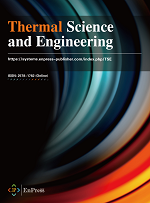|
eISSN: 2578-1782 Journal Abbreviation: Therm. Sci. Eng. |
Thermal Science and Engineering (TSE) is an international open access journal that publishes high-quality articles that span activities ranging from fundamental thermodynamic scientific research to the applied discussion of maximising thermodynamic efficiencies and minimising all heat losses. Topics cover thermal biology, nanotechnology, thermal energy transport, thermodynamics, thermal medical systems, and devices, etc. Interests include, are not limited to, those related to all areas of thermal science and engineering:
|
Online Submissions
Registration and login are required to submit items online and to check the status of current submissions.
Already have a Username/Password for Thermal Science and Engineering?
GO TO LOGIN
Need a Username/Password?
GO TO REGISTRATION
Submission Preparation Checklist
As part of the submission process, authors are required to check off their submission's compliance with all of the following items, and submissions may be returned to authors that do not adhere to these guidelines.
- The submission has not been previously published, nor is it under the consideration of another journal (or an explanation has been provided in Comments to the Editor).
- The submission file is in Microsoft Word format.
- Where available, URLs for the references have been provided.
- The text adheres to the stylistic and bibliographic requirements outlined in the Author Guidelines, which is found in About the Journal.
- If submitting to a peer-reviewed section of the journal, the instructions in Ensuring a Blind Review have been followed.
Privacy Statement
EnPress Publisher respects and strives to protect the privacy of its users and visitors. Hence, users and visitors are encouraged to read EnPress Publisher’s privacy policy regarding the usage and handling of user information.
(1) User information
Names and email addresses entered in all EnPress Publisher’s journal sites will be used exclusively for the stated purposes of the journals and will not be made available for any other purpose or to any other party. For submission and peer review, users should register an account for further procedures, including but not limited to name, email, address, interests, affiliation, and postcode, as editors need the information to complete in-house processes (e.g., processing a manuscript).
When users visit the publisher's website, information about the visit is saved in web logs (e.g., device, IP address, time of visit, etc.), which are only used to help improve the structure and content of the website.
(2) User rights
Users have the right to register or update their personal information and contact the publisher to cancel/delete their account if required.
(3) Third-party link
EnPress Publisher is not responsible for private information obtained by third-party websites when users log in via a pop-up screen from third-party software installed on their computer.
When users visit third-party platforms (e.g., LinkedIn, Twitter, COPE, etc.) through hyperlinks from EnPress Publisher’s journal websites, the privacy policy follows the policies of the third-party platforms.
(4) Queries or contact
For any queries about EnPress Publisher’s privacy policy, please contact the editorial office at editorial@enpress-publisher.com.
Article Processing Charges (APCs)
Thermal Science and Engineering is an Open Access Journal under EnPress Publisher. All articles published in Thermal Science and Engineering are accessible electronically from the journal website without commencing any kind of payment. In order to ensure contents are freely available and maintain publishing quality, Article Process Charges (APCs) are applicable to all authors who wish to submit their articles to the journal to cover the cost incurred in processing the manuscripts. Such cost will cover the peer-review, copyediting, typesetting, publishing, content depositing and archiving processes. Those charges are applicable only to authors who have their manuscript successfully accepted after peer-review.
| Journal Title | APCs |
|---|---|
| Thermal Science and Engineering | $500 |
We encourage authors to publish their papers with us and don’t wish the cost of article processing fees to be a barrier especially to authors from the low and lower middle income countries/regions. A range of discounts or waivers are offered to authors who are unable to pay our article processing charges. Authors can write in to apply for a waiver and requests will be considered on a case-by-case basis.
*Article No. is mandatory for payment and it can be found on the acceptance letter issued by the Editorial Office. Payment without indicating Article No. will result in processing problem and delay in article processing. Please note that payments will be processed in USD. You can make payment through Masters, Visa or UnionPay card.
Vol 8, No 2 (2025)
Volume 8, Issue 2 of this journal highlights significant advancements in the integrated application of thermodynamics, artificial intelligence, and advanced materials in the field of sustainable energy. Some featured findings include machine learning programs for electrolyzers, enabling efficient hydrogen production; ultra-high-efficiency vacuum insulated panels suitable for containers; and metal iodides and their applications in medical technologies. Additionally, a critical thermodynamic analysis quantifies the impact of trace gases on the storage of heat in the atmosphere of the Earth. These studies collectively drive innovation toward reducing the energy footprint.
Table of Contents
This study comprehensively evaluates the system performance by considering the thermodynamic and exergy analysis of hydrogen production by the water electrolysis method. Energy inputs, hydrogen and oxygen production capacities, exergy balance, and losses of the electrolyzer system were examined in detail. In the study, most of the energy losses are due to heat losses and electrochemical conversion processes. It has also been observed that increased electrical input increases the production of hydrogen and oxygen, but after a certain point, the rate of efficiency increase slows down. According to the exergy analysis, it was determined that the largest energy input of the system was electricity, hydrogen stood out as the main product, and oxygen and exergy losses were important factors affecting the system performance. The results, in line with other studies in the literature, show that the integration of advanced materials, low-resistance electrodes, heat recovery systems, and renewable energy is critical to increasing the efficiency of electrolyzer systems and minimizing energy losses. The modeling results reveal that machine learning programs have significant potential to achieve high accuracy in electrolysis performance estimation and process view. This study aims to contribute to the production of growth generation technologies and will shed light on global and technological regional decision-making for sustainable energy policies as it expands.
This study aims to investigate the enhancement in electrical efficiency of a polycrystalline photovoltaic (PV) module. The performance of a PV module primarily depends upon environmental factors like temperature, irradiance, etc. Mainly, the PV module performance depends upon the panel temperature. The performance of the PV module has an inverse relationship with temperature. The open circuit voltage of a module decreases with the increase in temperature, which consequently leads to the reduction in maximum power, efficiency, and fill factor. This study investigates the increase in the efficiency of the PV module by lowering the panel temperature with the help of water channel cooling and water-channel accompanied with forced convection. The two arrangements, namely, multi-inlet outlet and serpentine, are used to decrease the temperature of the polycrystalline PV module. Copper tubes in the form of the above arrangements are employed at the back surface of the panel. The results demonstrate that the combined technique is more efficient than the simple water-channel cooling technique owing to multi-heat dissipation and effective heat transfer, and it is concluded that the multi-inlet outlet cooling technique is more efficient than the serpentine cooling technique, which is attributed to uniform cooling over the surface and lesser pressure losses.
To investigate the effect of the location of vacuum insulation panels on the thermal insulation performance of marine reefer containers, a 20ft mechanical refrigeration reefer container was employed in this paper, and the physical and mathematical models of three kinds of envelopes composed of vacuum insulation panels (VIP) and polyurethane foam (PU) were numerically established. The heat transfer of three types of envelopes under unsteady conditions was simulated. In order to be able to analyze theoretically, the Rasch transform is used to analyze the thermal inertia magnitude by calculating the thermal transfer response frequency and the thermal transfer response coefficient for each model, and the results are compared with the simulation results. The results implied that the insulation performance of VIP external insulation is the best. The delay times of each model obtained from the simulation results are 0.81 h, 1.45 h, 2.03 h, and 2.24 h, while the attenuation ratios are 8.93, 20.39, 20.62, and 21.78, respectively; the delay times calculated from the theoretical analysis are 0.78 h, 1.43 h, 1.99 h, and 2.20 h, respectively; and the attenuation ratios are 8.84, 20.31, 20.55, and 21.72, respectively. The carbon reduction effect of VIP external insulation is also the best. The most considerable carbon reduction is 3.65894 kg less than the traditional PU structure within 24 h. The research has a guiding significance for the research and progress of the new generation of energy-saving reefer containers and the insulation design of the envelope of refrigerated transportation equipment.
Global energy agencies and commissions report a sharp increase in energy demand based on commercial, industrial, and residential activities. At this point, we need energy-efficient and high-performance systems to maintain a sustainable environment. More than 30% of the generated electricity has been consumed by HVAC-R units, and heat exchangers are the main components affecting the overall performance. This study combines experimental measurements, numerical investigations, and ANN-aided optimization studies to determine the optimal operating conditions of an industrial shell and tube heat exchanger system. The cold/hot stream temperature level is varied between 10 ℃ and 50 ℃ during the experiments and numerical investigations. Furthermore, the flow rates are altered in a range of 50–500 L/h to investigate the thermal and hydraulic performance under laminar and turbulent regime conditions. The experimental and numerical results indicate that U-tube bundles dominantly affect the total pumping power; therefore, the energy consumption experienced at the cold side is about ten times greater the one at the hot side. Once the required data sets are gathered via the experiments and numerical investigations, ANN-aided stochastic optimization algorithms detected the C10H50 scenario as the optimal operating case when the cold and hot stream flow rates are at 100 L/h and 500 L/h, respectively.
Metal iodide materials as novel components of thermal biological and medical systems at the interface between heat transfer techniques and therapeutic systems. Due to their outstanding heat transfer coefficients, biocompatibility, and thermally activated sensitivity, metal iodides like silver iodide (AgI), copper iodide (CuI), and cesium iodide (CsI) are considered to be useful in improving the performance of medical instruments, thermal treatment processes, and diagnostics. They are examined for their prospective applications in controlling thermal activity, local heating therapy, and smart temperature-sensitive drug carrier systems. In particular, their application in hyperthermia therapy for cancer treatment, infrared thermal imaging for diagnosis, and nano-based drug carriers points to a place for them in precision medicine. But issues of stability of materials used, biocompatibility, and control of heat—an essential factor that would give the tools the maximum clinical value—remain a challenge. The present mini-review outlines the emerging area of metal iodides and their applications in medical technologies, with a special focus on the pivotal role of these materials in enhancing non-invasive, efficient, and personalized medicine. Over time, metal iodide-based systems scouted a new era of thermal therapies and diagnostic instrumentation along with biomedical science as a whole.
The role of trace gases in the storage of heat in the atmosphere of the Earth and in the exchange of energy between the atmosphere and outer space is discussed. The molar heat capacities of the trace gases water vapor, carbon dioxide and methane are only slightly higher than those of nitrogen and oxygen. The contribution of trace gases carbon dioxide and methane to heat storage is negligible. Water vapor, with its higher concentration and conversion energies, contributes significantly to the heat storage in the atmosphere. Most of the heat in the Earth’s atmosphere is stored in nitrogen and oxygen, the main components of the atmosphere. The trace gases act as converters of infrared radiation into heat and vice versa. They are receivers and transmitters in the exchange of energy with outer space. The radiation towards space is favored compared to the reflection towards the surface of the Earth with increasing altitude by decreasing the density of the atmosphere and condensation of water vapor. Predictions of the development of the climate over a century by extrapolation are critically assessed.
Exposure to high-frequency (HF) electromagnetic fields (EMF) has various effects on living tissues involved in biodiversity. Interactions between fields and exposed tissues are correlated with the characteristics of the exposure, tissue behavior, and field intensity and frequency. These interactions can produce mainly adverse thermal and possibly non-thermal effects. In fact, the most expected type of outcome is a thermal biological effect (BE), where tissues are materially heated by the dissipated electromagnetic energy due to HF-EMF exposure. In case of exposure at a disproportionate intensity and duration, HF-EMF can induce a potentially harmful non-thermal BE on living tissues contained within biodiversity. This paper aims to analyze the thermal BE on biodiversity living tissues and the associated EMF and bio-heat (BH) governing equations.
Announcements
Volume 8, Issue 2 articles now available online! |
|
Volume 8, Issue 2 of this journal highlights significant advancements in the integrated application of thermodynamics, artificial intelligence, and advanced materials in the field of sustainable energy. Some featured findings include machine learning programs for electrolyzers, enabling efficient hydrogen production; ultra-high-efficiency vacuum insulated panels suitable for containers; and metal iodides and their applications in medical technologies. Additionally, a critical thermodynamic analysis quantifies the impact of trace gases on the storage of heat in the atmosphere of the Earth. These studies collectively drive innovation toward reducing the energy footprint. More details, please read Volume 8 Issue 2. |
|
| Posted: 2025-08-11 | More... |
Volume 8, Issue 1 articles now available online! |
|
Volume 8 Issue 1 presents innovative studies involving thermal properties analysis for phase change materials, solar-powered absorption refrigeration system, thermal management strategies and optimization of heat systems using numerical analysis methods. The issue also includes a comprehensive review on the role of nanomaterials in the manufacturing of micro and macro scale devices. These studies offer valuable insights to advance sustainable thermal energy technologies and thermal system design. The works in this issue are vital to develop critical solutions for engineering challenges in thermal systems. More details, please read Volume 8 Issue 1. |
|
| Posted: 2025-03-31 | More... |
Congratulations to Prof. Qingsong Wang on Receiving the 2024 Highly Cited Award from Clarivate Analytics |
|
 |
|
| Posted: 2024-12-18 | More... |
| More Announcements... |




 Open Access
Open Access
